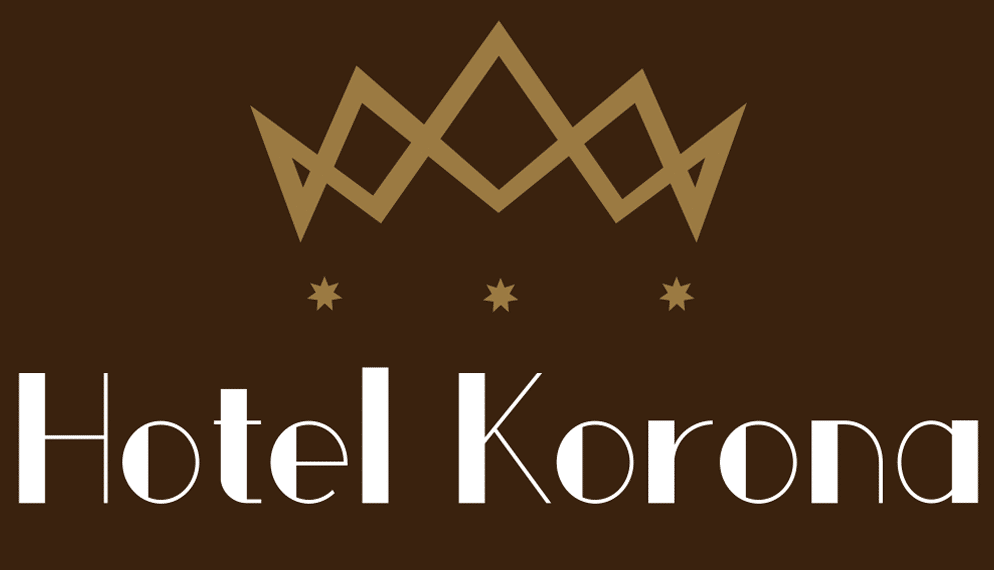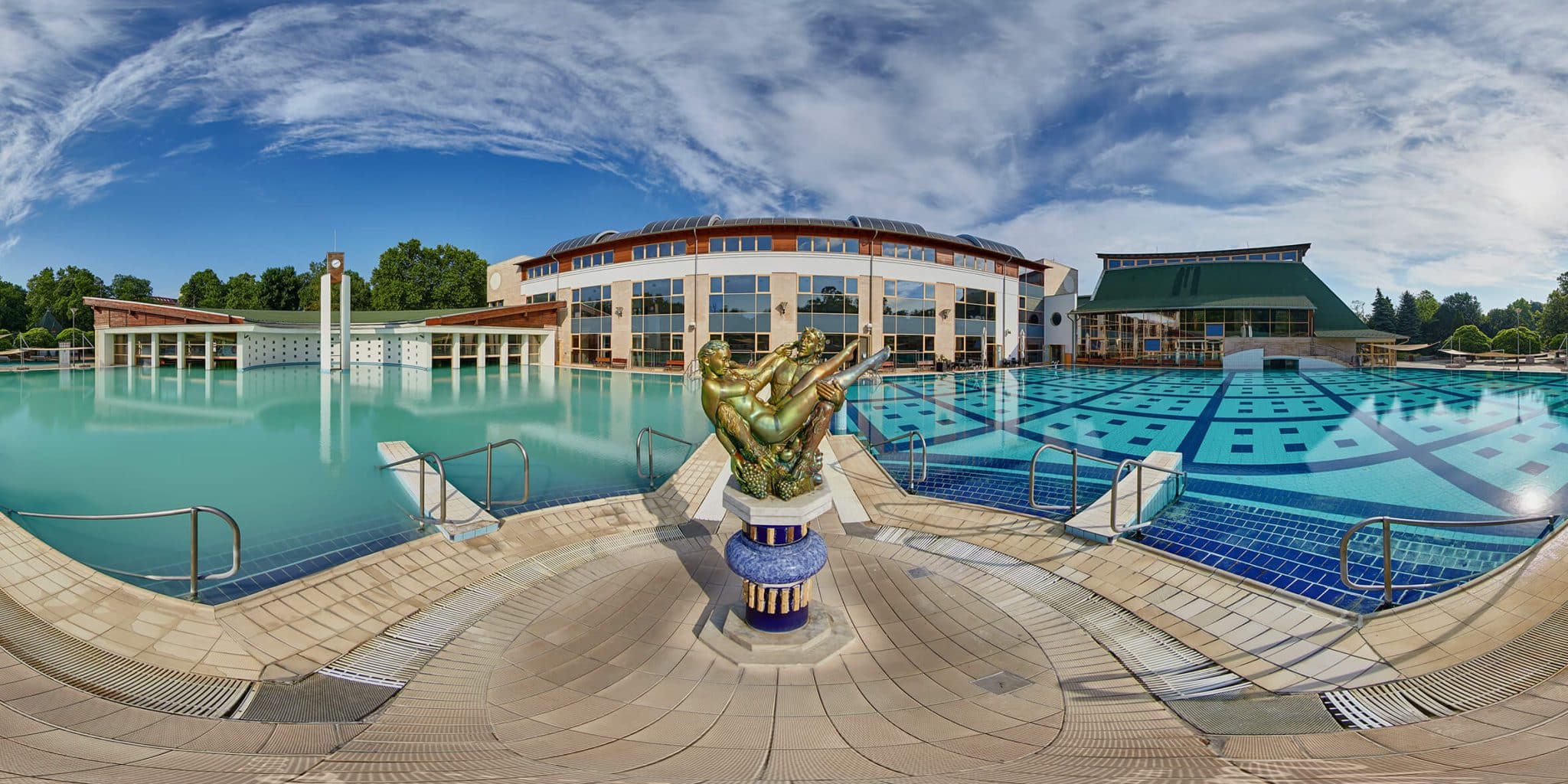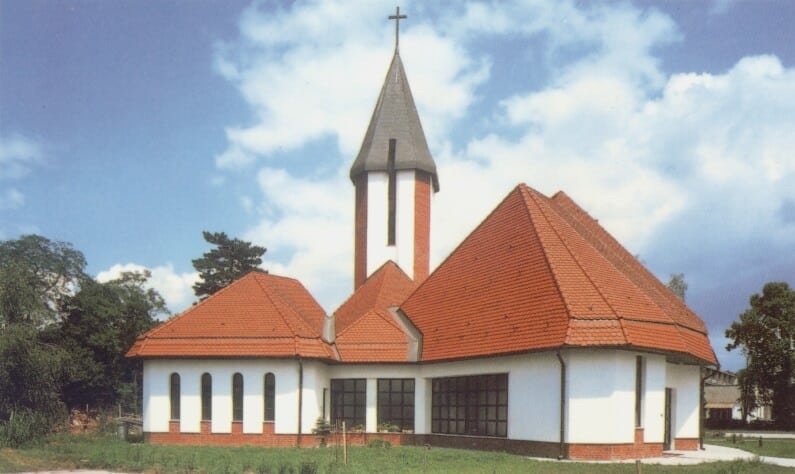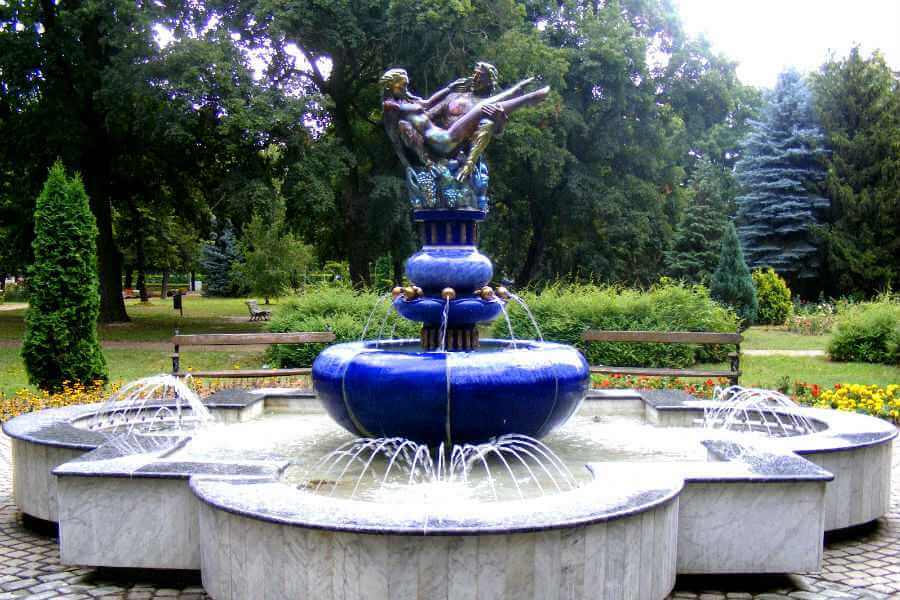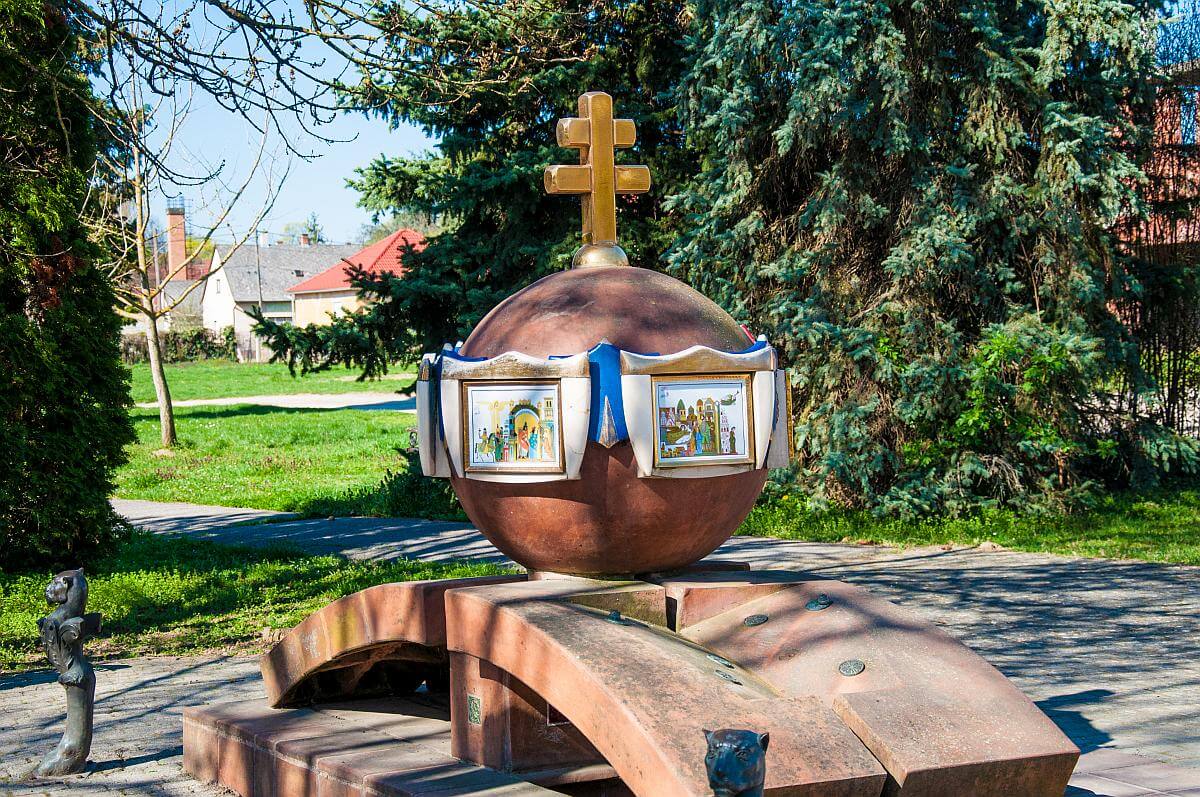Sights
Harkány
Thermal and Spa Bath
The ion-rich thermal water contains high amounts of dissolved carbonyl sulfide and sulfur, which have antispasmodic and muscle-relaxing effects in high-temperature water. The water is easily absorbed by the human body, effectively reduces inflammation, accelerates cell regeneration, and cleanses inflamed areas. These active compounds can heal or alleviate most musculoskeletal, rheumatic, and joint disorders. However, the healing power of Harkány water extends beyond this. It can also effectively reduce the symptoms of psoriasis over the long term, a property recognized internationally. This is significant, as no cure has yet been found for this skin disease; treatments are only temporary, and its recurring nature affects patients’ lives. The thermal water, however, can provide lasting symptom relief.
In addition to these remarkable and rare properties, Harkány water has proven beneficial in gynecological treatments, including infertility, pelvic inflammatory disorders, and other issues, with patients receiving individualized care in a calm, private environment. The specialized services and treatments, supervised by professional doctors at the Spa Hospital, are available year-round, treating more than 800 patients daily. The Spa’s fully developed infrastructure ensures complete relaxation and recreation for all visitors. Younger guests and those wanting to splash around can enjoy the swimming pool with various pools, slides, and colorful programs. Activities include Walkenergie programs, spinning, animators, concerts, and Spinn Fizz. For those seeking healing, services include massages, mud packs, bathtub treatments, light therapy, underwater exercises, electrotherapy, aesthetic treatments, psoriasis therapy, and many other therapies. More information: www.harkanyfurdo.hu
Sacred Heart Catholic Church
In the 19th century, the growing Catholic population and the increasing number of Catholic visitors to the spa made the construction of a church necessary. In 1906, a Catholic chapel was built, allowing Roman Catholics to practice their faith and attend Mass. The chapel was consecrated the same year to the Sacred Heart of Jesus. With the growth of Harkány’s population, by the mid-1980s, the local Catholic community exceeded 2,000 members, and tourism had increased. These factors necessitated the expansion of the original chapel, which could accommodate about 100 people. Construction began in 1985 based on plans by József Holczer, under the supervision of parish priest Ferenc Hopp. The original 1906 chapel was built in Neo-Romanesque and Neo-Gothic style, while the new church reflects modern architectural trends. The renovated church, six times larger in floor area, was consecrated on October 22, 1988, in the presence of thousands of worshippers. Since 1990, Harkány has been an independent Roman Catholic parish within the Diocese of Pécs. The exterior walls feature enamel Stations of the Cross by László Morvai, and the churchyard displays Hungarian historical stations, open daily from 9:00 a.m. to 8:00 p.m.
Opening hours: Daily partial visits from 9:00; winter: 15:30–18:00, summer: 17:30–20:00.
Address: 7815 Harkány, Ady E. Street 3.
Tel: +36-72-479-966
Reformed Church
Built in 1802 in late Baroque, Copf style, the Reformed Church stands on Kossuth Lajos Street, the spa town’s main street. Next to it is the bust of Mihály Sztárai, a 16th-century Reformer active mainly in Siklós. The Harkány Reformed congregation began building its church on March 21, 1798. The elegantly designed Copf-style building with a pyramidal tower was completed in 1802.
Address: 7815 Harkány, Kossuth u. 64.
Tel: +36-72-480-215
Terehegy Reformed Church
Built in 1798 and also under historic protection, this church is located on a small hill in the Terehegy district. The local Ormánság Reformed congregations were reorganized after Emperor Joseph II’s Tolerance Edict (1781). Churches in the region were mostly built in the late 18th and early 19th centuries, showcasing rural late Baroque, Copf, and Classicist architecture. The Harkány Terehegy Reformed Church was built around 1800 in Copf style by local villagers, with a unique 18th-century organ imported from Pécsvárad, still rare in Europe. The benches are in Baroque style. The church was renovated in 1988 with a ceremony featuring organist Dezső Kosaras from Debrecen.
Address: 7815 Harkány, Terehegyi u. 1/A
Tel: +36-72-480-215
Zsigmondy Promenade and Park
The spa’s development began in the mid-1820s, shortly after the healing effects of sulfur water were discovered. The first spa building was in Classical style, with an attached 28-room hotel. Landscaping of the area began soon after, with walking paths, trees, shrubs, and statues across 40 acres. The first wells to bring karst water to the surface were designed by mining engineer Vilmos Zsigmondy. The adjacent ancient park is named after him, featuring artworks and benches for visitors.
Harka Fountain
Located in Zsigmondy Park, the Harka Fountain commemorates the girl from Harkány legend. Built in 2000 from Zsolnay materials, it is decorated with motifs symbolizing the legend of Harkány water.
Országalmás Fountain
Created by László Vajda and Tamás Kamerer, the Millennium Országalmás fountain was inaugurated in 2000. Porcelain images in the style of manuscript initials circle the fountain. Various materials were used, including the coat of arms of Harkány City.
Nearby Attractions
Siklós – Máriagyűd
Siklós Castle: A landmark with nearly 800 years of history. Serving defense, military, and noble family residence purposes, it is one of the most important Hungarian Renaissance buildings. Modern renovations have made previously inaccessible Gothic sections viewable, with glass flooring added. A visitor center opened in 2011, and the castle hosts historical, artistic, and temporary exhibitions, along with concerts and theater performances.
Reformed Church: The local Reformed Church dates back to the Hungarian Reformation, with its first pastor being Mihály Siklósi.
Malkocs Bey Mosque: Built between 1543–1565, recognized by the Europa Nostra Award in 1993. Now functions as both a museum and prayer hall.
Serbian Orthodox Church: Built in 1738 by settlers, rebuilt after fire, with late Copf-style iconostasis and interior, now open to visitors.
Franciscan Church: Originally dedicated to St. Anne, mentioned in 1333. Adjacent monastery converted into a ceramics workshop in the late 1970s.
Máriagyűd Basilica: One of Hungary’s most important pilgrimage sites, built in the 18th century by Franciscan monks. Holds the Basilica Minor rank since 2008. Connects to the Hungarian Pilgrimage Route (El Camino style), a 420 km path from Esztergom to Máriagyűd.
Villány
Historic wine cellars along the main street offer local specialties. Visit the Wine Museum housed in the former Teleki cellar, showcasing traditional tools, documents, and century-old wine bottles. Villány’s former limestone quarry is a treasure for nature enthusiasts, rich in ammonite fossils. Geological research since 1910 has uncovered 27 new animal species across ten sites. The name “Villanyium” originates from the Pleistocene strata studied here.
Duna-Dráva National Park
The Villány Hills area is rich in cultural and natural heritage, featuring Mediterranean-influenced flora and fauna, including rare and protected species. Visitors can explore Szársomlyó or the wild floodplains of the Dráva River.
Palkonya
Named Europe’s Cultural Village in 2007. Features a red-domed Catholic church built by the Batthyány family in 1816. Preserves 18th-century German winegrowers’ architectural heritage, including 53 locally protected cellar houses.
Ormánság
Known for its churches, including painted ceiling Reformed churches in Drávaiványi, Kórós, Adorjás, and Kovácshida, with unique 18th–19th-century folk art decorations.
Pécs
A city of Mediterranean ambiance, culture, and history. Known for Roman, medieval, Turkish, and modern heritage. UNESCO World Heritage site since 2000. Notable museums include the Pécs Basilica Treasury, Janus Pannonius Museum, Ethnographic Exhibition, Csontváry Museum, Vasarely Museum, and Amerigo Tot Exhibition. Pécs was named European Capital of Culture in 2010. More info: www.iranypecs.hu
Pécsvárad
Historic town with vineyards, orchards, and the Pécsvárad Castle, home to a 10th-century chapel founded by King Stephen. More info: www.pecsvarad.info.hu
Orfű
Village in the Mecsek Valley, with four lakes ideal for swimming, boating, fishing, and recreation. Two are recreational lakes; two support fish farming. Visitors can enjoy walks, cycling, horseback riding, and boat rentals. More info: www.orfu.hu
Abaliget
Known for its cave and prehistoric artifacts, founded by the Aba family in the 11th century. Features boating and fishing lakes, and a developed cave path along an underground stream. More info: www.abaliget.hu
Other Leisure Activities
Dráva River Sightseeing Cruises: 45-passenger boats explore the Dráva region’s wildlife. Permanent dock at Drávaszabolcs, km 78. Contact: Sándor Fórizs +36-30-9593-530, www.dravahajo.hu
Hunting: Five local hunting societies operate around Harkány, including Drávamenti Hubertus, Ipacsfai, Ócsárd and Vidéke, Siklósi Táncsics, and Tenkes Kittenberger.
Fishing:
Ócsárd: Fishing center with ponds, restaurant, and wildlife park. Contact: Zoltán Horváth +36-30-226-5834
Szalánta: 1.5-hectare lake with facilities for cooking and grilling, children’s playground. Contact: Ferenc Tóth +36-20-928-3837, horgaszto@horgony.hu
Kovácshida Fishing Lakes: Three lakes covering 32 hectares, 5 km from Harkány. Fish include carp, grass carp, pike, catfish, bream, and perch. Inquiries: +36-72-707-121
